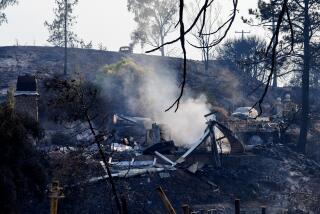Edison Role in ’96 Fire Found Not Criminal
CALABASAS — Southern California Edison failed to trim trees that brushed a power line and sparked the 1996 wildfire in Calabasas that injured seven firefighters, but its negligence was not criminal, prosecutors have concluded.
The evidence is insufficient to convict the utility of criminal wrongdoing in the fire, which destroyed more than 13,000 acres as it burned across the Santa Monica Mountains to the Pacific, according to a report signed by Los Angeles County Dist. Atty. Gil Garcetti.
“It is evident that Edison was not diligent in monitoring the trees in Calabasas,” according to the report, sent to the California Department of Forestry and Fire Prevention, which had requested the criminal investigation.
Calling the district attorney’s conclusion “very disappointing,” forestry officials said they will consider pursuing civil penalties against Edison.
“The fact that this case has been dropped and the aspect of criminal charges is not being pursued is very disappointing,” said Ronny Coleman, chief deputy director for the forestry department.
“We believe the Calabasas fire was caused by the negligence of Southern California Edison,” said Karen Terrill, the department’s chief information officer.
She said her department is mandated by the Legislature to attempt to recover the cost of fires, estimated at $7.6 million in suppression costs for the Calabasas blaze. She said another $12 million in property damage was caused by the fire, which destroyed nearly a dozen homes and other structures and critically injured Firefighter William Jensen.
Investigators reviewed about 50,000 pages of documents and concluded the fire was caused by tree branches striking a lightning arrester at the top of a pole, causing hot and molten metal and electrical sparks to ignite dry grass below.
Edison was the subject of an extraordinary search warrant last year served by state officials who contended the utility covered up evidence of its negligence in the start of the fire.
Allegations that Edison failed to provide sufficient data, and that the utility otherwise interfered with the inquiry into the fire, were confirmed by the report.
“Because Southern California Edison trimmed the trees back during the investigation and destroyed all but the tops of the three branches, we have no way of determining the exact position of any particular branch at the time of the fire,” according to Garcetti’s report, written by Deputy Dist. Atty. Michael J. Cabral.
A spokesman for Edison said the trees were trimmed to restore service to the area as high winds that fanned the wildfire to the sea continued for days.
“The tops of the trees were preserved,” said Tom Higgins, vice president for corporate communications.
The report concluded: “The evidence that exists establishes that Southern California Edison had a program in place to appropriately maintain the areas surrounding its poles and that the program was fully funded.”
Higgins said, “We are pleased that the district attorney’s office has decided to conclude the matter without a recommendation for continued criminal investigation. It is our intention to continue to work with the California Department of Forestry to resolve any other issues or concerns that they might have.”
About 50 investigators and law enforcement officers participated in the surprise raid last September on Edison headquarters in Rosemead and several branch offices. Called “Operation Lights Out,” investigators had a detailed layout beforehand of the headquarters building so that they could first rush for those documents most important to the investigation.
The forestry department had one of its investigators pose as an architecture student to draw floor plans of the headquarters.
Forestry investigators, with officials from the Public Utilities Commission, planned the raid after repeated clashes with Edison in previous civil cost-recovery cases. The Ventura County Fire Department and the U.S. Forest Service had also complained that Edison was uncooperative in supplying documents and leaving evidence untouched after fires.
Edison has repeatedly denied the allegations.
Coleman, the forestry department’s chief, acknowledged that bickering has diminished.
“We have experienced a considerable amount of cooperation with Edison recently, not necessarily linked with the Calabasas investigation, but in the overall approach to solutions of problems” such as vegetation management near and below power lines, Coleman said.
More to Read
Sign up for Essential California
The most important California stories and recommendations in your inbox every morning.
You may occasionally receive promotional content from the Los Angeles Times.










